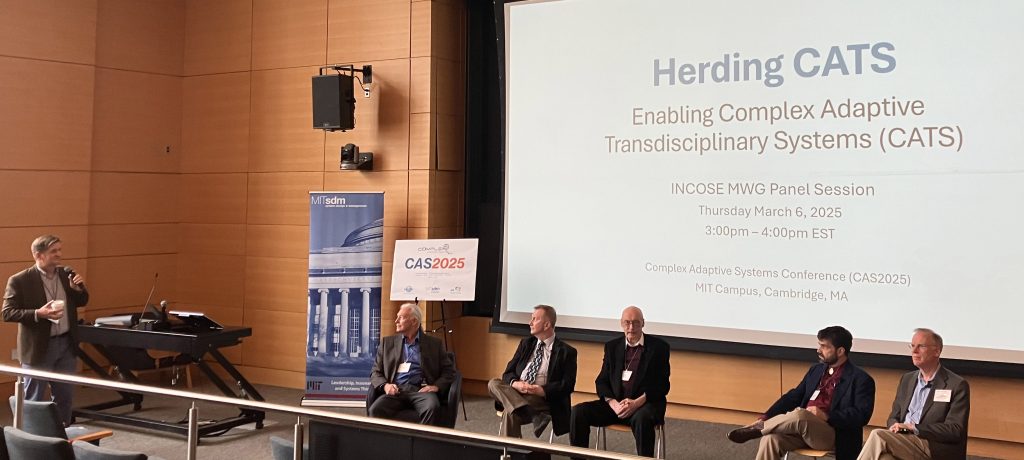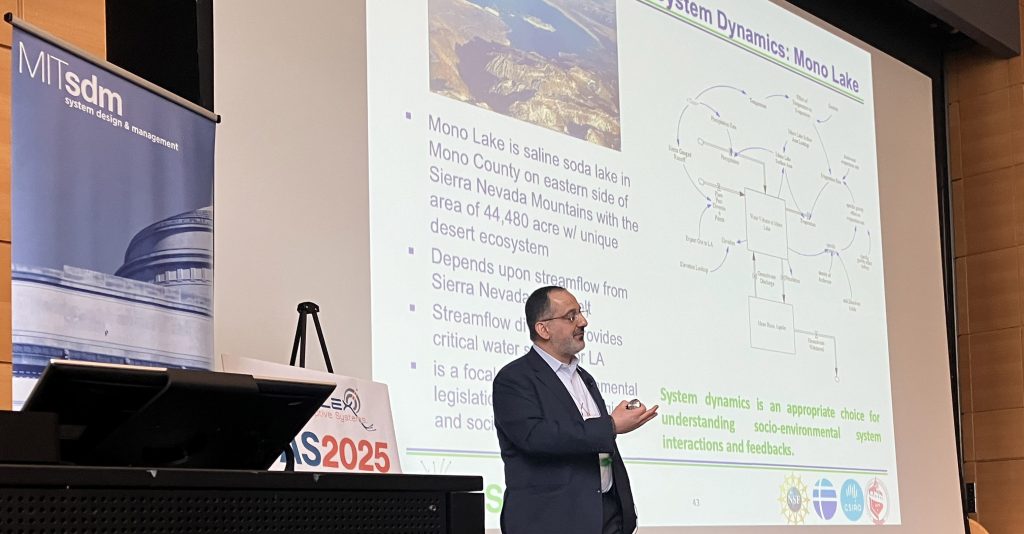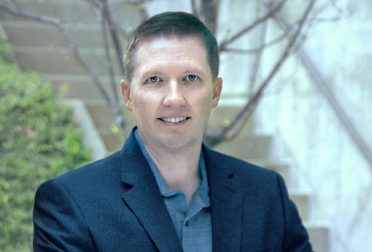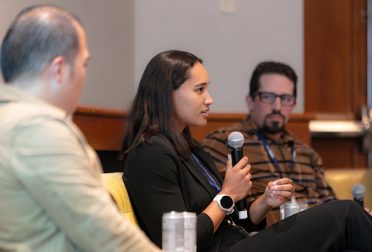Written by SDM fellows Jonas Urbonas, Mohammed Alsehali, Ben Arocho, Lal Bahadur, Michal Delkowski, Matt Mohler, and Myles O’Brien
Day 1
On Wednesday, March 5, Wong Auditorium was bustling at the start of the Complex Adaptive Systems conference, co-sponsored by MIT System Design and Management, IEEE Smart Cities, and INCOSE. There was a palpable excitement for the next three days of talks and workshops on complex systems engineering and architecting, delivered by industry leaders from various organizations.
The day opened with a keynote speech by Prof. John Sterman, Jay W. Forrester Professor of Management and director of the System Dynamics Group at the MIT Sloan School of Management. The talk focused on climate change and the impact of human activities on the increase in global atmospheric temperature. Prof. Sterman demonstrated the En-ROADS Climate Solutions Simulator, which illustrates the impact of individual contributing factors to climate change and the resultant effects of behavioral and policy change to reduce greenhouse gas by the year 2100. The talk was highly engaging and interactive, challenging our pre-conceived notions and testing the analytical thinking skills of the audience.
The keynote was followed by talks and workshops led by industry experts on diverse topics ranging from AI and machine learning to biological and cyber systems.
Steven Smith, Director of Flight Systems at Blue Origin, delivered a plenary session on aircraft safety systems. In all presented examples, the systems did what they were designed to do, but the human factor resulted in overall system failure, highlighting the importance of always considering the actions of a human actor when designing complex systems.
During Steven Smith’s talk, Mohammed was fascinated by the audience’s enthusiasm.
“This reminded me of the SDM core class when Bruce Cameron would ask us to read the news, observe systems in different disciplines, and share what we read in the classroom. Recently, we have discussed heartbreaking airplane accidents and tried to figure out the root causes of the issues. During Bruce’s classes, we were still trying to learn this new language of system thinking. Today I witnessed a full room of educated system thinkers who, despite coming from different backgrounds, were speaking the SDM language!”
– Mohammed Alsehali
Later, attendees listened to a panel discussion on INCOSE’s 2014 “Vision 2025 for the Future of Systems Engineering,” moderated by Prof. Olivier de Weck of the MIT Department of Aeronautics and Astronautics. A major topic of discussion was the unpredictability of the future, how that affected the accuracy of the vision for 2025, and how it should influence the new vision. Uncertainty is a consequence of living, and one of SDM’s core teachings is how to analyze and deal with uncertainty. System design experts were also surprisingly vulnerable to miscalculations of the future. The AI boom was not taken into account in the 2025 vision, but how could something like this be predicted? Nevertheless, we do our best to cover all possible scenarios and plan accordingly.
The day ended with a networking reception at the MIT Museum and a talk delivered by Mark Vriesenga, AI/ML & Cyber Systems Engineering Leader at BAE, on zero trust systems architectures. This talk covered the complexity of verifying information validity and accuracy in mission-critical systems and the design of zero-trust system architectures.
Day 2
Prof. Cihan Dagli of the Missouri University of Science and Technology opened the second day of Complex Adaptive Systems 2025 with his vision of the need for the transdisciplinary work presented at CAS. “Today, what we have are systems that are integrated and transdisciplinary. They are multifaceted, and they have been implemented at different levels. Some include humans, others might include algorithms. Because of all that, they create an ecosystem and emergent behavior.”
Prof. Ali Jadbabaie, JR East Professor of Engineering and head of the Department of Civil and Environmental Engineering at MIT, delivered a keynote highlighting several methods for collective decision making, including direct democracy, representative democracy, and “rule by experts” He advocated for a “liquid democracy” method that allowed participants to either use their vote directly or delegate it. Given the choice to vote or delegate, he stated: “If you have choices and feel informed, you make the best decision you can. If you have uncertainty, you try to project unknowns into the space of the knowns—by transferring your vote to someone with more subject knowledge.”
Thursday’s paper sessions included satellite characterizations, testing for deep space exploration, underwater exploration, and the use of AI to contribute to automate systems engineering or improve healthcare delivery.
Many presentations included familiar tools taught in System Design and Management program – Design Structure Matrices and Object Process Diagrams were used to decompose systems, identify trends, and analyze system data and connectivity. A good portion of the question-and-answer session was dedicated to verification and validation of AI models, highlighting model strengths and weaknesses. One paper from Rachel Dzieran of the Missouri University of Science and Technology analyzed the benefits of using AI to enhance the decision-making challenges facing organ transplant surgeons. The human and AI team made better informed decisions when faced with the chance of success. The AI model was treated as a peer in the toolkit, with the surgeon retaining the final decision power.
An afternoon session themed around research into system requirements explored improved requirements intake via interactive stakeholder interfaces, ontological decomposition of requirements into a coherent system project model, and strict requirements structure to ensure cybersecurity integrity. Additionally, a presentation on applying robust system engineering techniques to counteract the emerging proliferation of low-cost scalable UAVs in a military context demonstrated the adaptation of countermeasure systems to pace emerging threats.
Jack Stein of the INCOSE Risk Management Working Group advocated for transdisciplinary approaches in another panel discussion, saying, “We don’t want to approach issues as engineers, talking to other engineers, about engineering.” The minimum viable tool for transdisciplinary teamwork remained the whiteboard or pen and paper. “Don’t make the tool your impediment,” Stein added. The second day of the conference closed with a gala dinner and awards ceremony at Morss Hall, which celebrated outstanding contributions, fostering community and collaboration among researchers and industry leaders.

Day 3
The final day of CAS 2025 on Friday, March 7, featured an insightful keynote by Siqi Zheng, the MIT Center for Real Estate faculty director, focusing on urban systems and sustainability. The day proceeded with paper sessions presenting cutting-edge research on complex adaptive systems in areas ranging from climate adoption pathways by Prof. Richard de Neufville to system adaptability as a risk mitigation method by Haifeng Zhu et al.
After lunch, Amro Farid of IEEE Smart Cities delivered a plenary talk emphasizing the role of smart infrastructure in enabling adaptive resilience. The afternoon included a stimulating panel discussion exploring transdisciplinary approaches to managing complex systems, followed by a coffee break facilitating lively participant exchanges. The paper “Enhancing Project Adaptability in Early-Stage Systems Design using Concept Maturity Levels: A Comparative Study” from SDM co-director Ignacio Vazquez and current student Lal Bahadur took us through novel approaches to enhancing our understanding of systems engineering.

The day concluded with a final keynote from Dr. Michael Watson, president-elect of INCOSE, on applying systems engineering in high-stakes environments. Dr. Bryan Moser, academic director of SDM and the CAS conference chair, closed the session by thanking all participants and organizers and highlighting insights from the conference.




